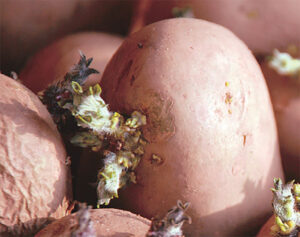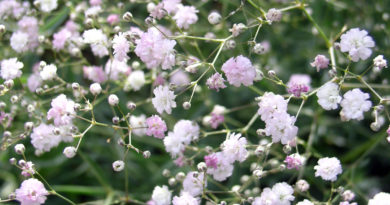They are the fourth largest food crop in the world, packed with nutrition, easy to grow and very versatile in the kitchen. The humble potato can be grown in straight rows in the garden plot, in bags or pots or tucked among the annuals to save space.
The word potato comes from the Spanish patata, which is a compound of the native word, batata or sweet potato, and papa, meaning potato. It’s all very confusing, but the bottom line is that potatoes are just as good by any other name, even spud, which apparently stems from a word used to describe potato-digging instruments.
As for taste – the store-bought spuds just can’t compare to the homegrown variety unless you have a farmer’s market next door.
Most are started from other potato tubers. Look for certified seed potatoes; the store-bought varieties have most likely been treated to retard sprouting. Potatoes do, however, produce true seeds which appear on the plants as small green, tomato-like balls after flowering. These seeds can be saved using the same methods as you would for saving tomato seeds, but be aware that the crop they will produce will be varied. Each seed may contain a different DNA and produce a potato different from its brother. This makes life interesting, if not predictable.
How to grow potatoes
Preparations. They prefer light, sandy soil, but will grow almost anywhere. If you are planting large numbers, make the soil as light and pebble- or lump-free as possible by tilling and raking. Then dig a shallow trench about three inches deep. Put fertilizer into the hole and cover that with an inch of soil. (The heavier the soil, the shallower the planting: two to three inches for clay soils, three to four inches for light sandy soils). You can also plant potatoes in individual holes.
Companion plants. Bush beans, cabbage family vegetables, parsnips corn and peas are all good companions for potatoes.

Seed stock. Potatoes sprout from their “eyes”, the small indentations on all potatoes. To use them as seed, you can cut each potato into sections. You need at least one and preferably two eyes on each cutting. Some gardeners recommend letting the cut seeding stock rest for 24 to 48 hours to allow a protective coating to form over the cut areas to reduce soil infection.
Sprouted seed potatoes. You can also give your seed potatoes an early start by allowing them to sprout in a bright room before cutting. Set them out in an open box in a warm, well-lit room 20 days before cutting and planting. They will produce small fuzzy green sprouts. Avoid breaking these off when cutting.
Planting out. The soil temperature should be about seven degrees C when you plant your seed potatoes. This is a more precise measurement than the vague advice about last frosts. The seedlings will take anywhere from 10 days to three weeks to come up, depending on conditions.
Spacing. Plant about one foot apart and, if planting in rows, leave 28 to 36 inches between rows so that you will have room to till and to hill.
Watering. Water consistently (potatoes are related to tomatoes; they are sensitive to inconsistent watering.) Over or under-watering can result in knobby, ill-shapen spuds. Water deeply. According to the National Gardening Association, “Potatoes get 57 percent of their water from the top foot of soil, 24 percent from the second foot of soil and as much as 13 percent from the third foot of soil.”
Hilling. Some gardeners recommend waiting until the potatoes have begun to bloom before hilling. Vesey’s Seeds suggests hilling when the plants are a foot tall. Hilling simply means piling six to eight inches of earth (or another mulch) up the stem to ensure that no light reaches to the tubers which will begin to grow from stolons reaching out from lower leaf axils. Sunlight will cause greening and the consequent production of toxic substances in your potatoes. Hill periodically as the potatoes grow.
Harvesting. You can begin to harvest in about 10 weeks from planting, generally in early- to mid-July. Simply dig down into the hill with your hands. Harvesting mature potatoes for storage should be left until late August and is usually aided by use of a potato fork to avoid damaging or bruising your crop. In colder areas, plants will die back after a first light frost, indicating it’s time for harvest.
Curing. Before storing, allow them to cure (toughen the skins) by letting them dry in a shady area for a few hours. Do not wash before storing – simply brush off any excess soil. Washing reduces their storage life. Wash just before cooking.
Storing. Potatoes should be stored in a cool dark place, ideally at about 10 degrees C. Do not store below four degrees C as this promotes the production of harmful acrylamides, chemical compounds which are considered carcinogenic and toxic.








Pingback: More about Potatoes - Canada's LOCAL Gardener magazine